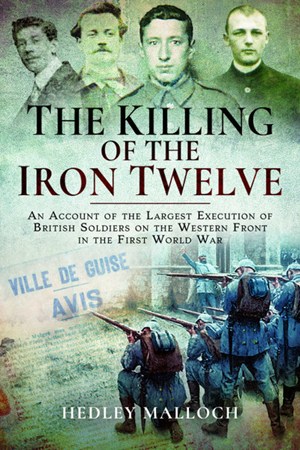THE KILLING OF THE IRON TWELVE
Author: Hedley Mallcoh
Publisher: Pen & Sword. Hardback, 246 pages, 42 illustrations
Published: July 2019
Price £19.99
ISBN: 9781526718570
A fascinating book that tells the dramatic story of eleven British soldiers and one civilian that were executed by the Germans behind the lines near Saint-Quentin during the First World War. This is a Great War story that is not often told. The last book on the subject that I can remember was Ben Macintyre’s ‘A Foreign Field’ which told the story of the ‘Villeret Four’ who were betrayed and shot in similar circumstances. The ‘Iron Twelve’ was the largest known execution of this nature of British soldiers in the war.
The narrative explores the Germany Army in occupied areas and is a real eye opener; the savagery is shocking to read as are the many tales of atrocities that occurred during these dark years. The book explains why and goes into the background of German rule in France and Belgium, describing what it was like living under occupation. The German Army put military law above the Hague Convention and justified these killings, whilst clearly they were illegal under international law. Military law of many countries had the death penalty, but this was taken to the extreme by the German’s. One story is told of a French civilian who was executed for possessing souvenirs from the Franco-Prussian War (1870-71), whilst another met an untimely death for keeping pigeons. The occupying forces became paranoid about spies, and any soldier on the run, dressed in civilian clothes or not, was likely to be shot. Those who know the Nurse Cavell story will know the background equally well of life under German military rule. It was brutal.
The humanity shown by the French to the many hundreds of British as well as French troops that found themselves behind the lines is heart-warming. The civilians did their best to provide food and shelter, but this was a highly dangerous thing to do; if caught the punishment would be severe, if not fatal. Whilst hundreds of soldiers surrendered, many more chose to hide out in the woods, forests and countryside of Northern France in the hope that friendly forces would soon retake this ground. When this did not occur, those who did not surrender or remained in hiding chanced their luck in attempting a home run. A few were successfully, but many more failed in these attempts.
In the area around the village of Iron the book goes into detail about the soldiers (Royal Munster Fusiliers, Connaught Rangers and also one cavalryman from 15th Hussars) who were supported by these villagers through the Autumn and Winter of 1914. Betrayed by another villager, the twelve were brutally beaten, trialed and then illegally executed. This book adds another chapter to life behind the lines, and the struggles to survive and get home, all of which resonates with the Edith Cavell story.
Hedley Malloch, who is chair of the Iron Memorial fund and Honorary Life Member of the RMFA, has done a wonderful job with his book, a true memorial in its own right to those that were executed; innocent soldiers who just happened to find themselves on the wrong side of the lines.


